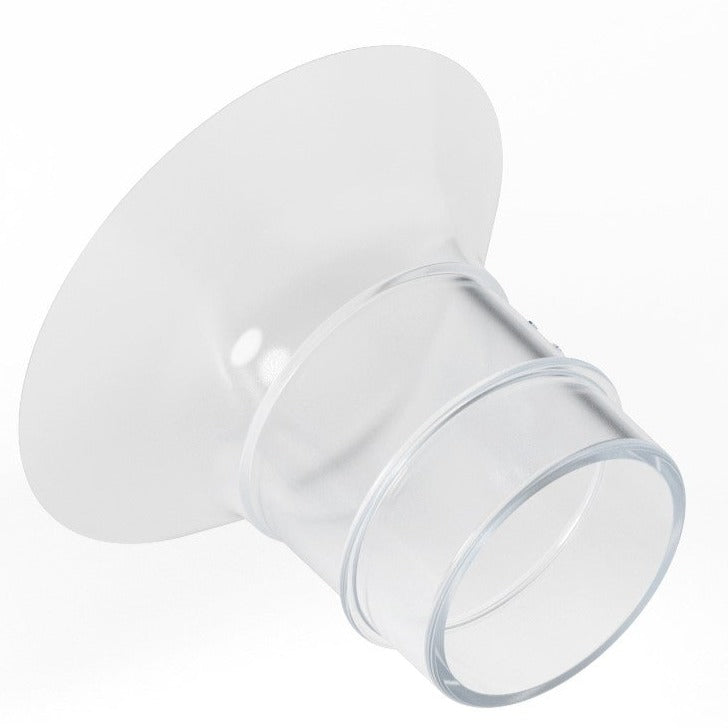When it comes to breastfeeding, there isn't always a one size fits all solution. Luckily, nowadays more and more mums are exploring the wonders and benefits of combining breastfeeding with hands-free breast pumps. And getting the correct flange fit for a breast pump is essential to get the maximum milk flow without causing pain or discomfort. But now that you're looking into getting your own, finding the right size can feel a little confusing. So let's simplify this with a guide to help you get that perfect fit for a comfortable breast pumping journey.
Quick Summary:
Having the right flange size will help maximise milk production and milk flow. Incorrect flange sizes can cause discomfort, nipple pain as well as damage your equipment. Getting the correct flange measurement starts by measuring your nipple.
What Is a Breast Pump Flange?

For starters, let's get acquainted with the breast pump flange! Simply put, the flange is the cone-shaped piece that attaches to the breast pump and fits around your nipple.2
Using the correct flange size helps you ensure an efficient milk expression. The right flange size is also a safety measure to prevent discomfort or damage to your breasts when pumping breast milk. When you are breastfeeding and pumping, your body can also undergo changes which would require you to check your flange size once in a while and change throughout your breastfeeding journey.
Related: How to Clean Breast Pump Flanges?
How Will You Know When a Breast Pump Flange Fits Properly?
Learning how to check if your breast pump flange fits properly can make a big difference. A well-fitted flange should allow your nipple to move freely within the tunnel without rubbing or pulling.
Before finding your measurement for a pump flange, you will need to measure your nipple. All you need to use is a nipple ruler or measuring tape1 to check the diameter of your nipple at the base (and of course) a simple step-by-step guide:
Use your measuring tape to find the diameter of your nipple (the horizontal width across it) in millimetres (1 cm = 10mm).
Do not include the areola, which is the outer edge around your nipple. Only measure the nipple alone and then add 4 mm to this measurement.
Make sure to measure both nipples in the case you may need two different sizes.
Based on your measurement, your breast pump flange size will help for effective pumping and prevent nipple damage or inadequate milk expression.
When Do You Need a Different Size?

Knowing your size is just as important as ensuring a correct flange fit for your breast pump's equipment. A flange that is too small or too big can lead to leaks, inefficiency, and potential damage. To know if you’re wearing the right size, pay attention to how your flange feels as it is quite normal for mums to change sizes now and then because of the changes that happen postpartum and while breastfeeding.4
What Happens When You Use the Wrong Flange Size?
When you have the wrong size, several problems can arise. It can lead to poor sealing between the flange and the pump, leading to leakage and potentially damaging the breast pumps. Secondly, the incorrect size can cause vibration and noise, disrupting the smooth operation of the system. Additionally, it can also lead to reduced efficiency and increased energy consumption of the pump.
Beyond the costly damage, getting the wrong measurements can cause breast milk supply issues and a lot of discomfort to your body. From engorgement to soreness around the areola, it would make your pumping session costly and a more difficult experience than it should be.
FAQ:
Will My Flange Size Change?
Many breastfeeding mums wonder if their flange size will change over time. Everybody is different. And while it is likely, how your body changes postpartum4 can vary from woman to woman during the breastfeeding journey. If there are any signs of an improper fit, such as pain3 or ineffective milk expression, it may be time to reassess and adjust your flange size accordingly. When in doubt, you can also seek advice from a certified lactation consultant. It is recommended to consult with a specialist to find your best flange size for a comfortable and successful breastfeeding experience.
Are Breast Pump Flanges Interchangeable?
Breast pump flanges are not always interchangeable, and it is important to use the correct flange fit for effective pumping.2 Flanges come in different sizes, and finding the right flange size can make a significant difference in comfort and milk output. Using flanges that are too small or too large can result in ineffective pumping and discomfort. It is recommended to measure nipple size before purchasing flanges to ensure the correct fit. While some breast pumps may offer universal flange compatibility, it is still crucial to choose the flange size that fits best for optimal milk extraction and a comfortable pumping experience.
What Happens if Breast Flange Is Too Big?
If the breast flange is too big, it can hinder your milk expression. When you're pumping with a correct flange fit, it can help for effective breastfeeding as it ensures proper nipple stimulation and milk flow. Whereas a flange size that's too large for the breast may not create a proper seal around the nipple, leading to decreased milk extraction. This can result in inadequate milk supply and engorgement. It may also cause discomfort, pain, or even damage to the nipple and areola tissue.6
What Happens if Breast Flange Is Too Small?
If the breast flange is too small it can cause compressed breast tissue, which may lead to clogged milk ducts and decreased milk supply.3 It can also cause nipple pain and redness or discolouration,5 as it may rub against the sides of the flange. To ensure an optimal pumping experience, it is important to choose the correct flange size based on the measurements of your nipples.
Does Flange Size Affect Milk Output?
When it comes to flange size, having the right size matters. The perfect flange can maximise your milk production greatly. On the other hand, using incorrect sizes will cause insufficient suction, inefficient milk removal, impeded milk flow and also cause harm to your body and your equipment. It is recommended to consult with a lactation consultant for guidance on the correct flange size for optimal milk production.3
The Right Flange Size Will Do Wonders for Breastfeeding

Choosing the right flange size can do wonders for your breastfeeding journey. While sizes may change along the way, getting to find a flange that fits directly over your nipple ensures optimal milk flow and comfort. It'll save you from any aches and pains and make sure your milk supply will always be ready for your growing little one. Hand-free breast pumps can be amazing, especially for mums on-the-go and the value they bring to your busy days will surely be worthwhile. So, take the time to measure your nipple size and choose the best fit for you. Investing in the right fit will not only enhance your breastfeeding experience but also support a successful and fulfilling bond with your baby.
References:
- https://support.motifmedical.com/hc/en-us/articles/360041402473-Finding-Your-Flange-Size
- https://www.healthline.com/health/breastfeeding/breast-pump-flange
- https://www.webmd.com/parenting/baby/what-to-know-about-a-breast-pump-flange
- https://motifmedical.com/blog/why-the-best-breast-pump-flange-size-is-important
- https://www.webmd.com/parenting/baby/what-to-know-about-a-breast-pump-flange
- https://www.whattoexpect.com/first-year/breastfeeding/breast-pump-flange-size



Share:
How to Clean Breast Pump Flange? (Step-by-Step Guide)
When Does Breastfeeding Get Easier? (A Guide for Mums)